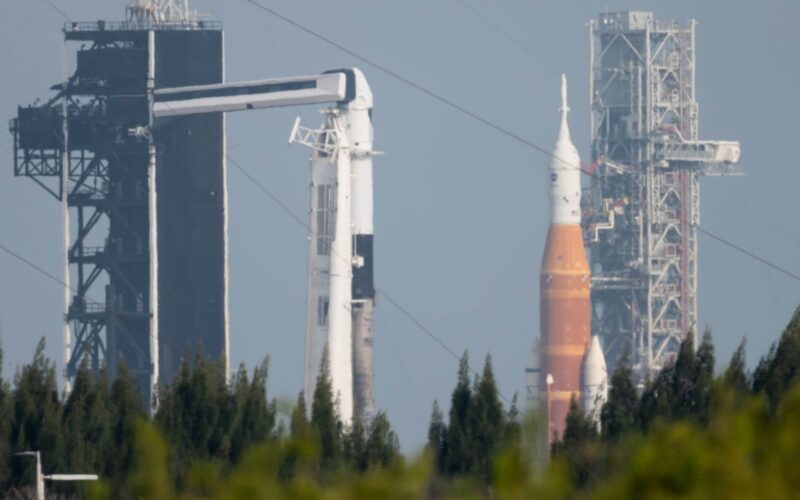Fate has not been particularly kind to NASA’s new mega rocket, the Space Launch System (SLS). However, it seems that during the past few years, the project has been given another chance at lift-off.
While the rocket was supposed to fly back in 2016, countless delays meant it became almost overshadowed by its main competitor, the SpaceX Starship. A chrome-adorned, retro-styled vehicle developed by Elon Musk’s fan-favorite corporation.
Following a series of explosive low-altitude tests the Starship was ostensibly ready to launch on its first orbital flight in 2021, but the launch was delayed pending the outcome of environmental reviews. This paved the way for the SLS to have a shot at becoming the first to launch.
However, it should be noted that the stakes in this race are not particularly high and the competition between SpaceX and NASA is purely figurative.
The question of prestige
The SLS, in its current configuration, can generate 8.8 million pounds of thrust, which is enough to earn it the title of the world’s most powerful rocket. According to SpaceX, the Starship is roughly twice as powerful as its competitor, and capable of generating around 17 million pounds of thrust – an amount that no future variant of the SLS could even come close to achieving.
So, if the SLS does manage to launch first, it will hold, however briefly, the title of the world’s most powerful rocket. But if Starship was to launch first, the title would become unbeatable.
It could be said that the remainder of NASA’s prestige currently hangs in the balance.
When it was envisioned in 2010, the SLS was tipped to be the world’s largest and most powerful rocket in addition to being extraordinarily cheap and quick to build due to ample use of existing components, such as engines and boosters from the Space Shuttle program.
Back then the Starship was simply a concept, as was the Falcon Heavy, the first attempt at heavy orbital vehicle undertaken by SpaceX, and roughly comparable in its payload capacity to the SLS.
Then, in 2014, NASA administrator Charlie Bolden uttered a quote that would go on to be ridiculed and memified ever since. “Let’s be very honest. We don’t have a commercially available heavy-lift vehicle. The Falcon 9 Heavy may some day come about. It’s on the drawing board right now. SLS is real.”
The Falcon Heavy launched in 2018. It’s now four years later and its successor, the Starship, is almost ready.
The SLS, with its countless delays and budgetary issues, has become NASA’s most controversial project in recent years, perceived as an outdated, unnecessary money sink, and a symbol of everything wrong with the industry.
It won’t become any less outdated or unnecessary if launched earlier than the Starship, but the record-breaking flight would at least give it some value. However, if SpaceX was to launch first, its engines would blow any pretense of the SLS’s importance out of the sky.
The race
The environmental review into SpaceX’s facilities gave the SLS a fighting chance, and NASA announced that the rocket would launch on August 29, 2022.
While the Federal Aviation Administration (FAA) gave SpaceX the green light in June, various regulatory hurdles meant that the company could not hope to launch the Starship before September 1, and even that date was just the start of the launch window, granted by one of many licenses needed for the actual flight.
But the SLS squandered its chances and the August 29 launch attempt was scrubbed just 40 minutes before the lift-off due to a faulty sensor. The second attempt on September 3 was interrupted by a liquid hydrogen leak, a far more serious issue which prompted NASA to debate if the rocket should be returned to the hangar for repairs.
As these events unfolded, SpaceX was busy conducting test after test of the newly assembled Starship prototype and a booster rocket. With a new engine and a host of other improvements, the new rocket is expected to be superior to the one that had been due to fly back in 2021 had the FAA not slowed down the program, increasing the chance of success for SpaceX. However, while usually overly optimistic regarding upcoming launches, Musk has been eerily silent this time, giving just the vaguest hint at plans for an orbital flight.
A *successful* orbital flight is probably between 1 and 12 months from now
— Elon Musk (@elonmusk) August 2, 2022
On September 6, 2022, NASA announced that it would attempt to fix the SLS on the launch pad, without undertaking the lengthy procedure of disassembling the rocket and bringing it back to the hangar. This indicates that another launch attempt is imminent, possibly within a matter of weeks, if not days.
Meanwhile, there is no indication that SpaceX will rush to launch the Starship.
So, there is little chance that Musk’s venture will beat NASA. Only if the SLS encounters another, more serious, technical failure (or catastrophic launch failure) will the Starship be given the upper hand.
But does the Starship have to launch first to be considered more successful than the SLS? Probably not.

